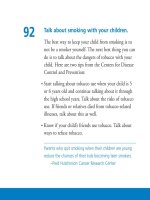212 five ways to shake shyness
Bạn đang xem bản rút gọn của tài liệu. Xem và tải ngay bản đầy đủ của tài liệu tại đây (106.34 KB, 3 trang )
Task 1
Give a heading to each of the following paragraphs. Choose from the list below. There
are two headings that you won’t need.
Smile all the time
Give yourself a chance
Start small with people you know
Rehearse what to say
Compliment people on their clothes
Develop your assertiveness
Think of some conversation starters
Before
Having a shy style isn't necessarily a problem. It's perfectly OK to take time to warm up to new
people and situations. But shyness blocks some people from being as comfortable or sociable as
they'd like to be.
Some people want to feel less shy so they can have more fun socializing and being themselves
around others. Here are some tips for overcoming shy feelings:
Practise social behaviours like eye contact, confident
body language, introductions, small talk, asking
questions, and invitations with the people you feel
most comfortable around. Smile. Build your
confidence this way. Then branch out to do this with
new friends, too.
When you're ready to try something you've been avoiding
because of shyness — like a phone call or a conversation
— write down what you want to say beforehand.
Rehearse it out loud, maybe even in front of the mirror.
Then just do it. Don't worry if it's not exactly like you
practised or if it's not perfect. Few of the things more
confident-seeming people do are perfect either. Be proud
that you gave it a go. Next time, it'll be even better
because it will be easier.
Because shy people can be overly concerned with other
peoples' reactions, they don't want to rock the boat. That
doesn't mean they're wimpy or cowardly. But it can
mean they are less likely to be assertive. Being
assertive means speaking up for yourself when you
should, asking for what you want or need, or telling other
people when they're stepping on your toes.
Often, the hardest part of talking to
someone new is getting started. Think of
conversation openers, like introducing
yourself ("Hi, I'm Chris, we're in the same
English class"), giving a compliment
("That jacket looks great on you"), or
asking a question ("Do you know when our
report is due?"). Being ready with a
conversation starter (or a few) makes it
easier to approach someone.
Find group activities where you can be with
people who share your interests. Give
yourself a chance to practise socializing with
these new people, and get to know them
slowly. People who are shy often worry about
failing or how others will judge them.
Worries and feelings like these can keep you
from trying. If self-criticism plays a role for
you, ask yourself whether you'd be this
critical of your best friend. Chances are you'd
be much more accepting. So treat yourself
like your own best friend. Encourage
yourself instead of expecting to fail.
Most of all, be yourself. It's OK to try out different conversational approaches you see others using. But say
and do what fits your style. Being the real you — and daring to let yourself be noticed — is what attracts
friends.
Source: kidshealth.org
Task 2
The following phrases come from the text. Match them with their synonyms or
definitions
1.
2.
3.
4.
5.
6.
7.
branch out
give it a go
speak up for sb
step on one’s toes
rock the boat
warm up to
keep sb from
A.
B.
C.
D.
E.
F.
G.
do sth that upsets the balance of a situation
try
extend in a new direction
prevent sb from doing sth
annoy sb
state clearly what you think on behalf of sb
get used to and begin to like
Task 3
Find the words in the text that the following definitions refer to.
feeling trust in oneself
excessively
form an opinion about sth/sb
give support and help
practise for public performance
find a way of solving s problem
friendly, fond of other people’s company
weak and timid
expression of praise or admiration
showing a strong and confident personality
______________________
______________________
______________________
______________________
______________________
______________________
______________________
______________________
______________________
______________________
Task 4
Answer the following questions.
When does shyness cause serious problems?
__________________________________________________________________________
What is meant by ‘social behaviours’?
__________________________________________________________________________
What is the role of conversation starters in fighting shyness?
__________________________________________________________________________
What is the best way to practise phone calls?
__________________________________________________________________________
What effect can self-criticism have on shy people?
__________________________________________________________________________
Why don’t shy people like to be involved in difficult situations?
__________________________________________________________________________
Can you overcome shyness by imitating confident people?
__________________________________________________________________________
Task 5
Discuss some questions with a partner, then share your experiences with other people in
your class.
Are there many people who would like to be less shy?
Are you one of them?
Are there any situations when you are extremely shy?
When do you feel confident and sociable?
Which piece of advice did you find the most useful? Why?
Have you ever tried any of them?
Source: kidshealth.org
After
Answer Key
Task 1:
1. Start small with people you know
2. Rehearse what to say
3. Develop your assertiveness
4. Think of some conversation starters
5. Give yourself a chance
Task 2:
1 – C; 2 – B; 3 – F; 4 – E; 5 – A; 6 – G, 7 – D
Source: kidshealth.org









